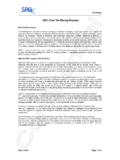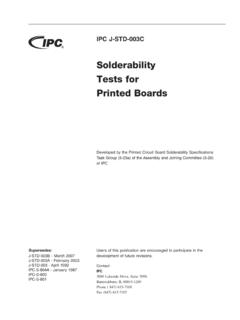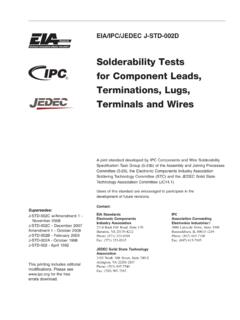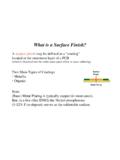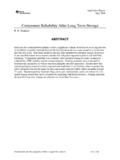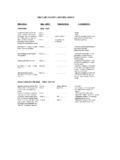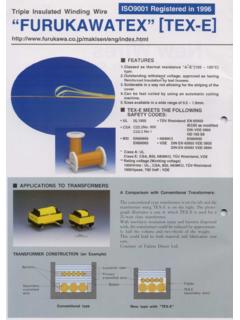Transcription of Shelf-Life Evaluation of Lead-Free Component Finishes
1 Application ReportSZZA046 - June 20041 Shelf-Life Evaluation of Lead-Free Component FinishesDouglas W. Romm, Donald C. Abbott, and Bernhard LangeABSTRACTThe integrated circuit (IC) industry is converting to lead (Pb)- free termination Finishes forleadframe-based packages. IC Component users need to know the maximum length of timethat components can be stored prior to being soldered. This study predicts shelf life of theprimary Pb- free Finishes being proposed by the industry. Components were exposed to acontrolled environment, with known aging acceleration factors. The Pb- free componentswere exposed to a Battelle Class 2 environment both in and outside of their normal packingmaterials. Results show that the Pb- free -finished ICs stored in tubes, trays, or tape-and-reelpacking material pass solderability testing after 96-h exposure to the Class 2 exposure correlates to eight years in an uncontrolled indoor environment, such as.
2 Background4.. Procedure5.. Assessment Methods and Results8.. Visual Examination8.. Surface-Mount solderability Test8.. Corrosion Products Analysis9.. Wetting-Balance Results11.. Board Mount12.. Visual Appearance of Solder Joints14.. Cross Sections of Solder Joints16.. Lead Pull18.. Summary of Results20.. Conclusion20.. Acknowledgments20.. References21.. Trademarks are the property of their respective Evaluation of Lead-Free Component FinishesList of Figures1. Schematic of MFG Chamber5.. 2. Group 1A NiPdAu m Pd, Loose, 96 h, 25 , Bottom Lead View9.. 3. Group 1A NiPdAu m Pd, Loose, 96 h, 200 9.. 4. Group 2A NiPdAu m Pd, Loose, 96 h, 25 10.. 5. Group 2A NiPdAu m Pd, Loose, 96 h, 25 10.. 6. Group 3A NiPdAu m Pd, Loose, 96 h, 25 10.. 7. Group 3A NiPdAu m Pd, Loose, 96 h, 200 10.. 8. Group 6A NiPdAu m Pd, Loose, 96 h, 25 11.. 9. Group 6A NiPdAu m Pd, Loose, 96 h, 200 11.
3 10. Reflow Profile Used for 20-Pin SOIC Units13.. 11. Reflow Profile Used for 16-Pin SOIC Units13.. 12. Group 1A, NiPdAu Finish, Stored Loose, 96-h Exposure14.. 13. Group 1B, NiPdAu Finish, Stored in Tubes, 96-h Exposure14.. 14. Group 2A, NiPdAu Finish, Stored Loose, 96-h Exposure14.. 15. Group 2B, NiPdAu Finish, Stored in Tubes, 96-h Exposure14.. 16. Group 3A, NiPd Finish, Stored Loose, 96-h Exposure14.. 17. Group 3B, NiPd Finish, Stored in Tubes, 96-h Exposure14.. 18. Group 4A, Sn Finish, Stored Loose, 96-h Exposure15.. 19. Group 4B, Sn Finish, Stored in Tubes, 96-h Exposure15.. 20. Group 5A, SnPb Finish, Stored Loose, 96-h Exposure15.. 21. Group 5B, SnPb Finish, Stored in Tubes, 96-h Exposure15.. 22. Group 6A, NiPdAu-Ag Finish, Stored Loose, 96-h Exposure15.. 23. Group 6B, NiPdAu-Ag Finish, Stored in Tubes, 96-h Exposure15.. 24. Group 1A, NiPdAu Finish, Stored Loose, 96-h Exposure16.
4 25. Group 1B, NiPdAu Finish, Stored in Tubes, 96-h Exposure16.. 26. Group 2A, NiPdAu Finish, Stored Loose, 96-h Exposure16.. 27. Group 2B, NiPdAu Finish, Stored in Tubes, 96-h Exposure16.. 28. Group 3A, NiPd Finish, Stored Loose, 96-h Exposure17.. 29. Group 3B, NiPd Finish, Stored in Tubes, 96-h Exposure17.. 30. Group 4A, Sn Finish, Stored Loose, 96-h Exposure17.. 31. Group 4B, Sn Finish, Stored in Tubes, 96-h Exposure17.. 32. Group 5A, SnPb Finish, Stored Loose, 96-h Exposure18.. 33. Group 5B, SnPb Finish, Stored in Tubes, 96-h Exposure18.. 34. Group 6A, NiPdAu-Ag Finish, Stored Loose, 96-h Exposure18.. 35. Group 6B, NiPdAu-Ag Finish, Stored in Tubes, 96-h Exposure18.. 36. Average Lead-Pull Force for Sample Groups 1 319.. 37. Average Lead-Pull Force for Sample Groups 4 619.. SZZA0463 Shelf-Life Evaluation of Lead-Free Component FinishesList of Tables1. Battelle Class 2 MFG Test Conditions6.
5 2. Component Evaluation7.. 3. Ni, Pd, and Au Thickness Measurements7.. 4. Visual-Inspection Results8.. 5. solderability Test Results9.. 6. Wetting-Balance Results (Time to Wet, in Seconds)12.. SZZA0464 Shelf-Life Evaluation of Lead-Free Component FinishesIntroductionThis study determines the shelf life of integrated circuit (IC) packages with lead (Pb)- free finisheson their leads or terminations. TI defines lead (Pb)- free or Pb- free to mean RoHS[1]compatible, including a lead concentration that does not exceed of total product weightand, if designed to be soldered, suitable for use in specified Lead-Free soldering processes.[2]Any product designed to be soldered and designated as Pb- free by TI does not simply utilize aPb- free finish, but is also suitable for use in high-temperature soldering (250 C/260 C), per theapplicable industry standards. Palladium (Pd)-based Finishes are the primary Pb- free finishesused for leadframes plated prior to assembly of the IC package.
6 [3,4,5] Pd-based finishesincluded in this study are nickel/palladium (NiPd), nickel/palladium/gold (NiPdAu), andnickel/palladium/gold/silver (NiPdAu-Ag). Matte tin (Sn) is a Pb- free finish also being proposedas a replacement for tin/lead (SnPb) plating. Components with matte-Sn-finished leads and, as acontrol, components with SnPb-finished leads are included in this study. The Sn or SnPb finishis plated after molding of the IC assessment of the shelf life of NiPd-finished components was done in the past by exposureof NiPd-finished components to Battelle Class 2 mixed flowing gas (MFG) conditions. That studyshowed no degradation of soldering performance after an exposure period that correlated toeight years of shelf storage.[6] In another study, solderability and board-mount testing onNiPd-finished units that had been stored for 51 months showed no degradation in solderingperformance of the NiPd-finished units.
7 [7]This follow-up Shelf-Life study was prompted by the expanded use of NiPdAu finish, as well asplans for the use of matte-Sn Finishes by some IC manufacturers and subcontract assembly/testhouses supplying Pb- free method used to assess shelf life , as measured by Component lead solderability , is toexpose the subject devices to a known, controlled atmosphere that accelerates the effects ofnormal environmental exposure. This is a useful tool if reasonable care is taken to select a testmethod and conditions so that the time acceleration factor is valid, and the failure mechanismsare consistent with real-world conditioning (formerly known as steam aging) of the IC units prior to solderability testingis a common procedure used in the industry. Previous work has shown that when Pd-finishcomponents are steam conditioned, mold resins or other organic residue may be deposited ontothe surface of the Pd.
8 Such deposits prevent dissolution of the Pd during solderability testing.[5]The solderability mechanism of NiPd or NiPdAu is dissolution of the Pd (and Au, if present) andwetting the Ni. In contrast, for SnPb- and Sn-finished leads, the soldering mechanism is a fusing(melting) of the Sn or SnPb on the lead and wetting to the Cu base metal. If contaminants fromsteam conditioning are on the surface of either Sn or SnPb, they float from the finish surfacewhen it melts. This artifact of the steam conditioning process does not correlate with actualstorage conditions for NiPd- or NiPdAu-plated leads. Steam conditioning prior to solderabilitytesting has proven to be a nonreproducible method for predicting solderability performance ofNiPd and similar nonfusible coatings. For the Shelf-Life study documented in this report, aconditioning method was used with known acceleration factors and with a mechanismapproximating that seen in the real Shelf-Life Evaluation of Lead-Free Component FinishesProcedureTo study shelf life by solderability testing of surface-mount ICs, a Battelle Class 2 MFGenvironment was selected.
9 This test has been well characterized by previous work andrepresents a slightly corrosive indoor atmosphere where the gas concentrations and humiditylevels result in corrosion of plated copper (Cu) materials, but not copper creep corrosion.[8,9]Class 2 environments generally are described as indoor environments having no humiditycontrol, such as that typically found in a test was conducted in a MFG chamber designed to the schematic shown in Figure 1. Thetest conditions are shown in Table 1 and are described in detail in ASTM B827 92.[9]H2 SNO2CI2 Permeation Tube ChambersExhaustExhaustTestChamberPerfora tedLucite BaffleCirculationFanDistributionManifold Interior ofHumidity CabinetPurifiedAirPurifiedAirFigure 1. Schematic of MFG ChamberSZZA0466 Shelf-Life Evaluation of Lead-Free Component FinishesTable 1. Battelle Class 2 MFG Test ConditionsTEST CONDITIONRANGECl2 concentration10 3 ppbNO2 concentration200 50 ppbH2S concentration10 5 ppbRelative humidity70 + 3%/ 0%Temperature30 2 CChamber volume change3 to 6 times per hourAcceleration factor400 1000It is important to include standard reactivity coupons along with the test of mass gain on the coupons confirms that proper test conditions were achievedand facilitates verification of acceleration factors.
10 [11]Subject surface-mount IC devices, with the various Finishes (see Table 2), were placed in thechamber, both unprotected and partially protected from the gas flow. Unprotected samples weretotally exposed to the MFG environment, , placed in an open petri dish. Additional samplesfrom the same lots were left in the typical (opened) packing used in product shipment. SOIC swere left in shipping tubes and in tape-and-reel packing materials. None of the parts were inhermetic anti-static bags or cardboard shipping/packing boxes when tested. The minimumspecified thickness and vacuum X-ray fluorescence thickness measurements of samples fromeach of the Pd-based lots are shown in Table 3. No thickness measurements were done on theSn and SnPb lots that were obtained from commercial attenuation effect of the packing materials (tubes and trays) was significant. Abbott (of Battelle) has stated that the attenuation by packing materials is perhaps the major reasonthat electronic components can perform reliably in field environments.










